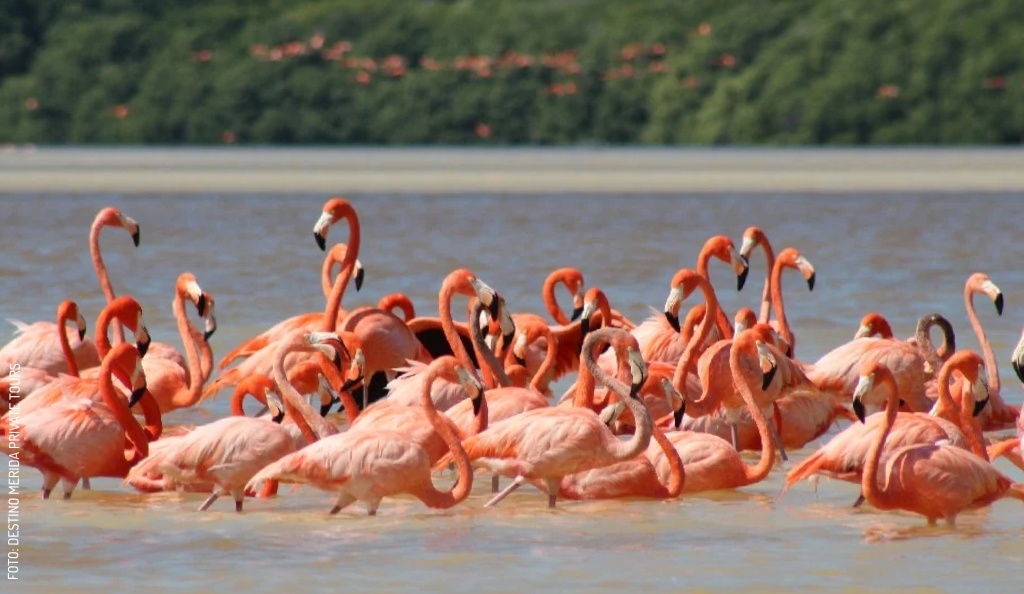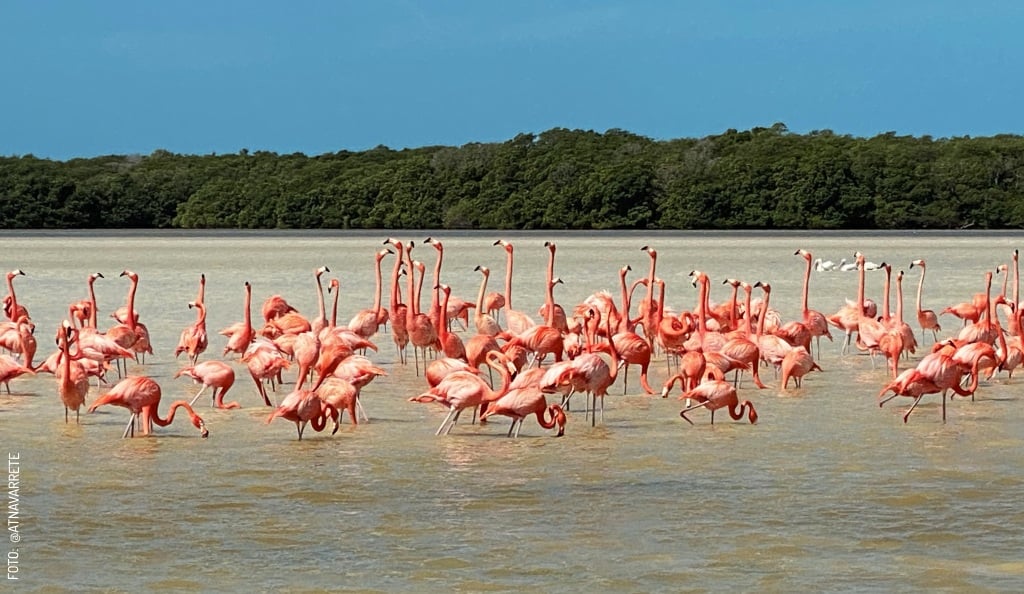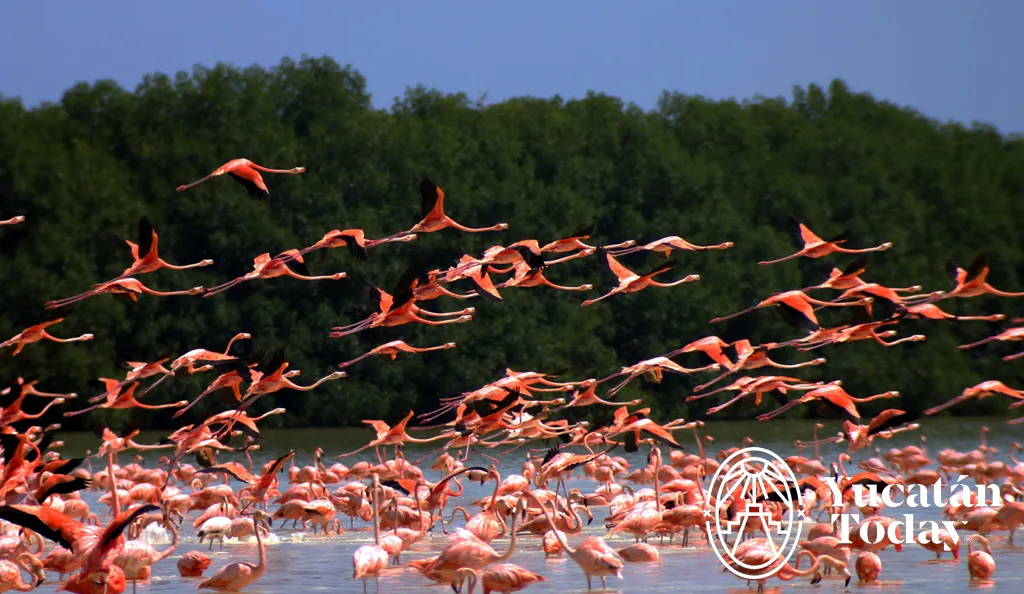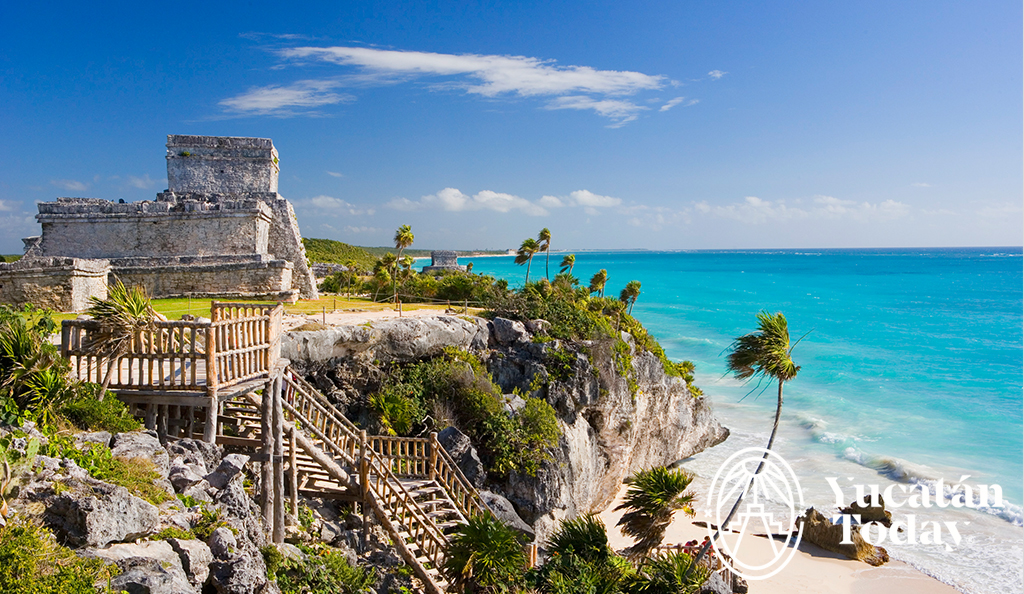
Day Trip: Celestún
Every tourist guide I have consulted recommends a trip to Celestún. They cite the boat excursions through the tidal estuary of the Ría Celestún Biosphere Reserve that afford views and photo opportunities of the vast flocks of flamingos and hundreds of other bird species; a swim in the clear, cool fresh water springs that bubble to the surface and drain into the estuary; a stop to view the “petrified forest”; and a ride through the sloughs that penetrate the dense mangrove forests that flank the estuary.
The tourist guides also encourage lunch in one of the town’s many seafood restaurants. If you only have time for a day trip, the round-trip can be done in one day; however, it is highly recommended to spend a few nights in this peaceful, beautiful part of Yucatán. There are several hotels to choose from, listed at the end of this article. The tourist guides are right. Celestún is well worth a visit. The exhilarating boat ride, bouncing through the Gulf waters to the Southern end of the peninsula upon which the town of Celestún resides and which separates the Gulf from the estuary, is itself worth the trip. There are a number of ways to go to Celestún, for both independent and group travelers.
If you’re driving, go west toward Uman and Kinchil, and keep going. Be sure to stop and visit the small towns along the way. On your return trip be sure to turn north at Kinchil for a visit to Hunucmá and a return to Mérida along a different route. If you prefer group travel, led by a guide, there are any number of Merida travel agencies where you can book a tour. Being one who prefers independent travel, I opted for a servicio intermedio (second class) bus from the Merida Bus Station on Calle 67 between Calles 50 and 52. The station is modern, spacious, and clean; with polite and helpful attendants, a couple of snack vendors, a waiting area with TVs, and handicap-accessible restrooms. Buses leave every hour, on the hour, beginning at 6:00 am.
 Likewise, return buses leave Celestún every hour, with the latest leaving at 8:00 pm. The bus traveled through the towns of Hunucmá, Kinchil, and a number of smaller communities which afforded views of traditional Mayan homes and other interesting local sites. The bus stopped frequently along the way, wherever it was flagged down and at town stations, to take on and discharge passengers. The trip is about two hours, with a bathroom stop in Hunucmá. Upon arrival, I was immediately approached by a fellow who identified himself as Hector Marine and who speaks at least five languages, including Spanish, English and Italian. Hector asked us each if we were there for a boat excursion.
Likewise, return buses leave Celestún every hour, with the latest leaving at 8:00 pm. The bus traveled through the towns of Hunucmá, Kinchil, and a number of smaller communities which afforded views of traditional Mayan homes and other interesting local sites. The bus stopped frequently along the way, wherever it was flagged down and at town stations, to take on and discharge passengers. The trip is about two hours, with a bathroom stop in Hunucmá. Upon arrival, I was immediately approached by a fellow who identified himself as Hector Marine and who speaks at least five languages, including Spanish, English and Italian. Hector asked us each if we were there for a boat excursion.
While Hector showed a couple to their hotel, I walked the one block to the beach to wait with the group of barcaderos, who arrange excursions and pilot the boats. Six eight-seat boats with fabric roofs waited at the shore. I was shortly instructed to join a very nice family of five wading through the light surf to board a boat piloted by Pedro, our muy amable young barcadero, who provided very informative commentary identifying the various species of flora and fauna and explaining the sights. I learned that there are also tour boats which leave from the estuary side of the peninsula, but they apparently charge more.
Their tour takes less time because the trip does not include a high-speed ride down the Gulf coast to access the estuary. After we settled into our seats - four of which line each side of the heavy fiberglass hull - Pedro gunned the motor, the bow elevated, and we were off on a 20 minute, bow slapping dash down the Gulf coast to the estuary entrance. A bit further along we stopped at a small dock and disembarked for the visit to a fresh water spring bubbling to the surface amidst the mangroves, of which, Pedro explained, there are red, black, and white varieties.
My fellow passengers enjoyed a swim in the cool, crystaline water. The spring is essentially a cenote nestled in the mangrove forest, with an outlet to the estuary. The limestone bedrock beneath the shallow water imparts a stony, gray hue to the otherwise turquoise Gulf water and an even darker hue to the water of the shallower estuary. The shallow water required Pedro to steer a wide circle around the tip of the peninsula and after entering the estuary the hull would occasionally scrape the bottom, prompting Pedro to order us to the bow to counterweight the heavier stern.

After entering the estuary Pedro steered the boat north, continuing under the bridge over which the bus had passed to enter Celestún, and stopped a few times along the way to check his crab pots, which were marked with plastic bottle floats. Beyond the bridge there are indeed large flocks of flamingos. These are pink, Pedro informed us, due to their beta-carotene rich diet. There are also lots of gray and white pelicans, cormorants everywhere, vultures circling overhead, egrets, and many other species of birds. I have read that the Celestún Biosphere Reserve is home to about 300 species.
After a time viewing and photographing flamingos, Pedro turned our boat south for the return trip. He steered the boat through a mangrove-lined slough and then landed the boat on the sandy estuary shore where we disembarked for the short walk to the “petrified forest”, which, as I suspected, is not really petrified. The forest is what along the Washington coast of the USA is referred to as a “ghost forest.” The sandy soil subsided 80 to 100 years ago, thus allowing the intrusion of seawater which killed the trees. The gray, decaying ghosts of the trees remain standing.
My companions, a bit chilly after their swim, opted to disembark at a dock on the estuary side of the peninsula and walk ten minutes back to town. I opted to return to the playa in the boat with Pedro and was treated to the sight of a beach filled with gray pelicans and more of Pedro’s informative commentary. Before reaching the playa and the other barcaderos, I thanked Pedro with a well-deserved $50 peso tip. Upon disembarking I eschewed the tourist-oriented, beach side restaurants and settled into the Nicte-Ha restaurant one block back from the beach.
The beers were $6 pesos cheaper than in the beach bistros; and - though I didn’t compare lunch prices - I suspect that my lunch of lightly fried fish filets, tomatoes and onions in vinegar, rice, and a stack of 15 warm, corn tortillas was also less expensive. Other attractions also lacking in the beachfront restaurants are waiters who go about their duties holding a baby in one arm and the chatter of the grandchildren of the proprietors sitting in a corner watching TV.
The entire trip, including Pedro’s tip, was less than $80 US. It was another great day in the Yucatán. Day Trip to Celestún by Chris Brown Share your day trip. Write us an email to: info@yucatantoday.com
Download your Map of:
In love with Yucatán? Get the best of Yucatán Today delivered to your inbox.
Don’t miss out on our latest articles and the digital magazine before anyone else.
Related articles

Celestún, A Pink Jewel
Celestún is an ecotourism paradise on the Yucatán coast that you will love for its clear skies, wildlife, and beautiful beaches.
Celestún
Located 60 miles southwest of Merida, Celestún is a quaint fishing village where the beaches are lovely





